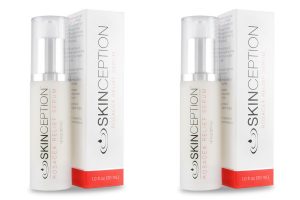
Acne rosacea just ain’t fair. While some people waltz through life without knowing the redness and embarrassment, those it affects know that rosacea sucks, with a face that looks like a tomato and a dry, prickling pain that, frankly, really hurts!
Well, if you can relate, you can take some solace in knowing that an estimated 14 million Americans suffer from rosacea. Some of them may ring a bell – Mariah Carey, Rosie O’Donnell and Bill Clinton have all struggled with this debilitating condition.
Skinception ™ Rosacea Relief Serum – Treats a Common Problem
Heck, even JP Morgan, one of the most prominent Americans in history, had rosacea. So much so, in fact, that he hated having his picture taken and rarely appeared in photographs.
We hope that isn’t you. But if it is, there’s hope. Skinception Rosacea Relief Serum reduces the redness and pain of acne rosacea and even prevents outbreaks before they start.
How does it work? We’ll get to that. But first, let’s learn more about rosacea, and what you can do to minimize the effects it has on your life.
What is Rosacea?
Acne rosacea is a chronic redness of the face. Most often it hits along the forehead, nose, under the eyes and the chin. In extreme cases, it can spread to the neck, ears and scalp.
This acute skin condition usually affects caucasians of north European descent, but can strike peoples of other ethnicities. Women are three times more likely to suffer from rosacea than men, and most often between the ages of 30 and 50.
Symptoms of acne rosacea include:
- facial redness, seen as bumps and non-acne pimples,
- red lines along the face,
- dry, prickly sensations,
- a swollen nose.
You’re more vulnerable to rosacea if you’re fair-skinned and/or easily blush. Common causes of rosacea outbreaks include stress, hot weather, exposure to the wind and spicy foods (Mexican food, hot peppers, garlic and paprika).
How Can I Treat Rosacea?
At present, there is no cure for this disease. That said, most doctors agree that it’s vital to identify rosacea as soon as possible, and take precautions to reduce outbreaks. And that’s a good idea, because repeated inflammation of the facial skin can damage the integrity of the blood vessels under the skin. Among other things, rosacea can damage collagen, cause blood pools and visible, prominent veins. And therefore, it’s a wise idea to use Skinception ™ Rosacea Relief Serum. The sooner, the better.
This serum is a comprehensive and natural therapy for your skin. Among its benefits, a reduction in symptoms and prevention of future outbreaks.

Sufferers of rosacea typically have very sensitive skin and often can’t use traditional skin care products for fear of an outbreak. Skinception™ Serum is specifically formulated to address the causes and minimize, even prevent outbreaks and symptoms of rosacea.
The benefits of Skinception™ Rosacea Relief Serum include:
- soothes and calms inflamed skin,
- redness and discoloration fade,
- improves blood circulation so red/purple spider veins fade,
- restores a normal sensitivity threshold to skin,
- reduces instances of burning/prickling,
- sensations on skin,
- thickened skin is softened,
- elasticity, tone, & firmness are improved,
- moisturizes without causing flare-ups.
Safe, affordable and designed specifically for the hypersensitive skin of customers prone to rosacea outbreaks, Skinception Rosacea Relief Serum is a gentle and effective alternative to moisturizing creams.
In a recent clinical study, Renovage®, an active ingredient in Skinception ™ Rosacea Relief Serum, reduced redness in acne rosacea patients by up to 90%. Barrier function improved by 75%, and skin roughness improved in at least 75% of study participants.
What does that mean?
Well, with less redness there’s less embarrassment. You’re more likely to feel confident in your appearance with normal complexion. Improved skin barrier means your body can absorb vital nutrients like vitamin C, while locking out trigger ingredients found in many common skin products. In other words, you’re less vulnerable to breakouts.
And less skin roughness? Your skin will be smoother, with less bumps and fewer pimples. You’ll look better, and you’ll experience something that most patients seek but rarely find: relief.
Fortunately, with Rosacea Relief Serum, there’s plenty of that!
The Complete Skinception™ Rosacea Relief Serum Ingredients
Actives: Renovage ™, Mediacalm ®, Actiflow ® EL, Allantoin.
Delivery: Hydrolite 5, Symglucan.
Ingredients: Water, Caprylic Capric Triglycerides, Isopropyl Palmitate, Silica, Titanium Dioxide, Iron Oxides, Pentylene Glycol, Beta Glucan, Teprenone, Butylene Glycol, Boerhavia Difussa Root Extract, Saccharomyces Cerevisiae Extract, Stearyl Alcohol, Panthenol, Magnesium Aluminum Silicate, Glyceryl Stearate, Sodium Stearoyl Lactylate, Allantoin, Sodium Lactate, Camellia Sinensis (Green Tea) Leaf Extract, Vitis Vinifera (Grape) Seed Extract, Vaccinium Myrtillus (Bilberry) Extract, Silybum Marianum (Milk Thistle) Extract, Pinus Pinaster Bark (Maritime Pine) Extract, Ginkgo Biloba Extract, Na-Carbomer, Xanthan Gum, DMDM Hydantoin, Pentaerythrityl Tetra-Di-t-Butyl Hydroxyhydrocinnamate.
References & External links
- Wilkin, Jonathan, et al. “Standard classification of rosacea: report of the National Rosacea Society Expert Committee on the Classification and Staging of Rosacea.” Journal of the American Academy of Dermatology 46.4 (2002): 584-587.
- Berg, M. A. T. S., and S. T. U. R. E. Liden. “An epidemiological study of rosacea.” Acta Derm Venereol 69.5 (1989): 419-423.
- Plewig, Gerd, and Albert M. Kligman. Acne and rosacea. Springer Science & Business Media, 2012.
- Crawford, Glen H., Michelle T. Pelle, and William D. James. “Rosacea: I. Etiology, pathogenesis, and subtype classification.” Journal of the American Academy of Dermatology 51.3 (2004): 327-341.
- Wilkin, Jonathan K. “Rosacea: pathophysiology and treatment.” Archives of dermatology 130.3 (1994): 359-362.
- Akpek, Esen Karamursel, et al. “Ocular rosacea: patient characteristics and follow-up.” Ophthalmology 104.11 (1997): 1863-1867.
- Powell, Frank C. “Rosacea.” New England Journal of Medicine 352.8 (2005): 793-803.
- Marks, Ronald, and John Nigel Harcourt-Webster. “Histopathology of rosacea.” Archives of dermatology 100.6 (1969): 683-691.
- Yamasaki, Kenshi, and Richard L. Gallo. “The molecular pathology of rosacea.” Journal of dermatological science 55.2 (2009): 77-81.










